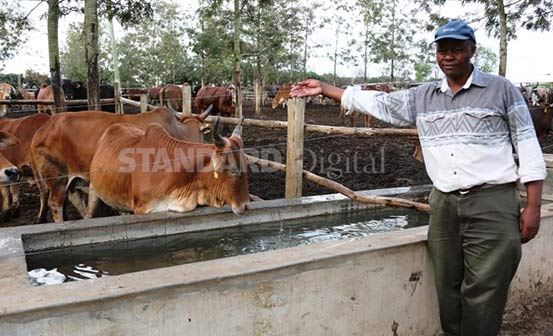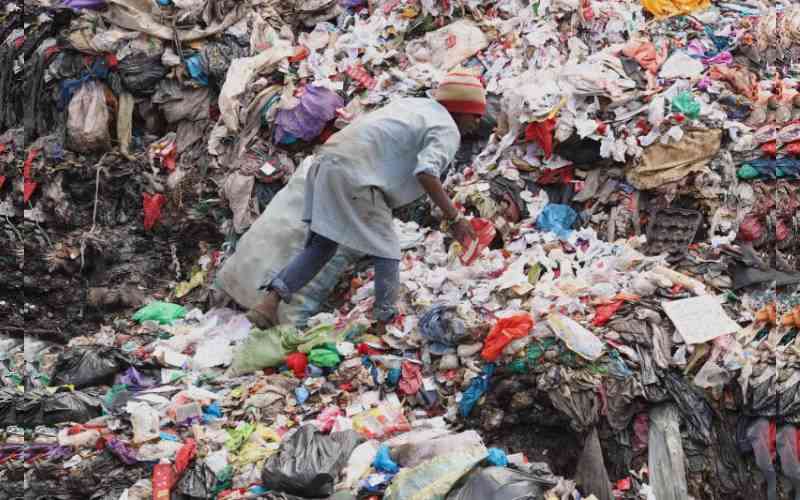
For the past one year, David Gakuo and his business partner Betty Gikonyo have reaped benefits of venturing where no one else in Kenya had dared to.
The two veterinary doctors saw an opportunity in the beef industry and grabbed it. Dr Gakuo and Dr Gikonyo have established the first commercial feedlot farm in Kenya, where livestock are fed and fattened up in a process known as finishing before they are sold off to the highest bidder.
The two set up an intensive system of beef production that focuses on feeding cattle for 90 days on concentrate feeds till they reach the desired market weight.
The feedlot system is a universally used practice in beef production but had never been introduced into the country for commercial purposes until the two doctors took it up.
Good prices
“We offer a unique opportunity to save beef farmers from huge losses. The toughest part for most farmers is to ensure the animals reach the desired market weight and fetch good prices,” says Gakuo. Their farm is located in Milimani village, Kieni Constituency.
Most beef farmers in Kenya are pastoralists based in arid and semi arid areas prone to harsh climatic conditions.
This leaves farmers vulnerable to losing their prized livestock and end up selling high value animals at throwaway prices.
“We ask farmers to sell to us their cows when they are a year old instead of staying with animals that put pressure on the pastures and then during the dry season it is too late to save them,” Gakuo says.
Gakuo travels to various livestock markets where he buys cattle for between Sh18,000 to Sh30,000 depending on the breed. Most of these are normally emaciated or underweight.
The animals are then transported to his farm in Kieni where they are vaccinated and isolated for two weeks before they are introduced to the paddock where the rest of the animals are kept.
“We make sure the animals are not carrying any harmful diseases so they do not infect the rest of the herd. They are then tagged and weighed before the feeding programme starts,” Gakuo says.
Gakuo and Gikonyo have two paddocks, each occupying an acre and with a capacity of 400 cattle.
“Unlike ordinary farmers who combine grazing on pastures and animal feeds, the feedlots are zero grazing units that focus on animal feeds with the intention of fattening the animal,” Gakuo tells Smart Harvest.
Stay informed. Subscribe to our newsletter
Gakuo says while the product of dairy cows is milk and beef, for beef cattle the product is the calf.
Each year, a healthy beef cow should calf, which means if you have five cows, you should have 10 animals by the end of the year. The number will keep increasing each year.
However, increasing your herd potential will only happen if you make room for these animals by avoiding straining the resources at your disposal.
Gakuo has come up with his own formula to ensure maximum results within 90 days. He has also set up a feeds factory which produces and sells his own brand of animal feeds.
“We came up with a formula for animal feeds which contain high energy, optimum protein, vitamins and minerals by combining, grains, cotton seed oil cakes and commercially manufactured supplements,” he says.
“Making our own feeds and establishing the factory, allows the business to save on money and adds revenue to the company,” he says.
After three months of intensive feeding, Gakuo sells an animal at between Sh60,000 and Sh90,000 depending on the breed.
High quality
“The market for high quality beef products is lucrative because there is a high demand for meat, locally and internationally. We never have a problem selling our animals,” he says.
Since May last year, Gakuo has bought and sold close to 2,400 animals.
“We restock every month and we sell the animals at the same rate, so it is a source of steady income. We plan to expand the farm from two acres to six acres of land with six paddocks,” he says.
Gakuo insists that the beef industry offers an opportunity to create jobs and ensure food security for all Kenyans, especially in arid areas.
“Currently, we are forced to import cotton seed oil cakes from neighbouring East African countries since they are a crucial ingredient for our animal feeds. The cotton industry should be revived to save us from this extra cost,” he says.
He says ranchers and pastoralists who have large tracts of land but fail to make the most from their animals can benefit from their venture.
“High quality breeds are the next important step in improving the quality of meat. Farmers need to be facilitated to access the best animal breeds and artificial insemination methods in the region,” Gakuo says.
The veterinarian says the feedlot industry could offer beef farmers even those in harsh climatic areas to improve the quality of their animals and ensure they earn more money in the market.
 The Standard Group Plc is a
multi-media organization with investments in media platforms spanning newspaper
print operations, television, radio broadcasting, digital and online services. The
Standard Group is recognized as a leading multi-media house in Kenya with a key
influence in matters of national and international interest.
The Standard Group Plc is a
multi-media organization with investments in media platforms spanning newspaper
print operations, television, radio broadcasting, digital and online services. The
Standard Group is recognized as a leading multi-media house in Kenya with a key
influence in matters of national and international interest.
 The Standard Group Plc is a
multi-media organization with investments in media platforms spanning newspaper
print operations, television, radio broadcasting, digital and online services. The
Standard Group is recognized as a leading multi-media house in Kenya with a key
influence in matters of national and international interest.
The Standard Group Plc is a
multi-media organization with investments in media platforms spanning newspaper
print operations, television, radio broadcasting, digital and online services. The
Standard Group is recognized as a leading multi-media house in Kenya with a key
influence in matters of national and international interest.






